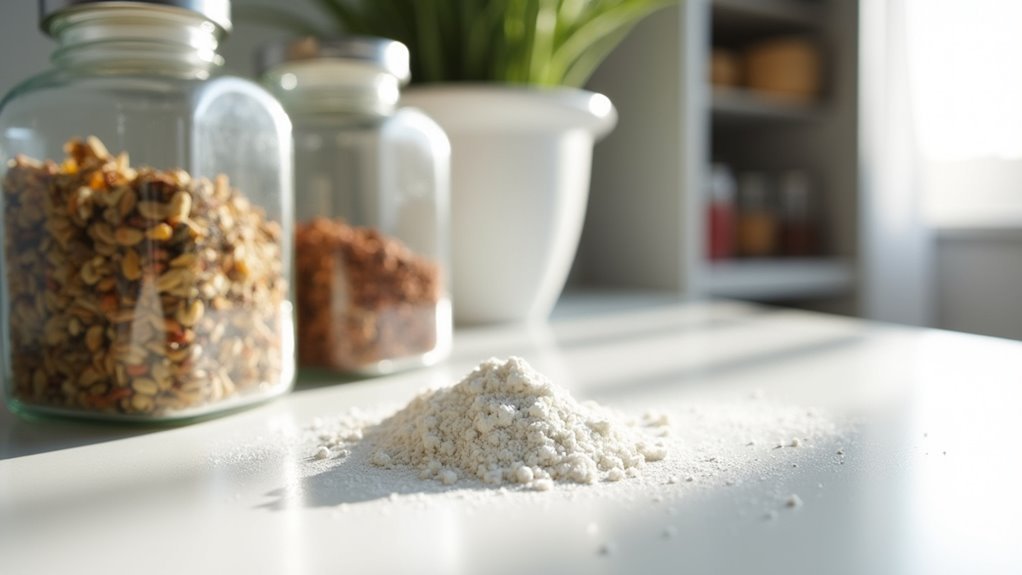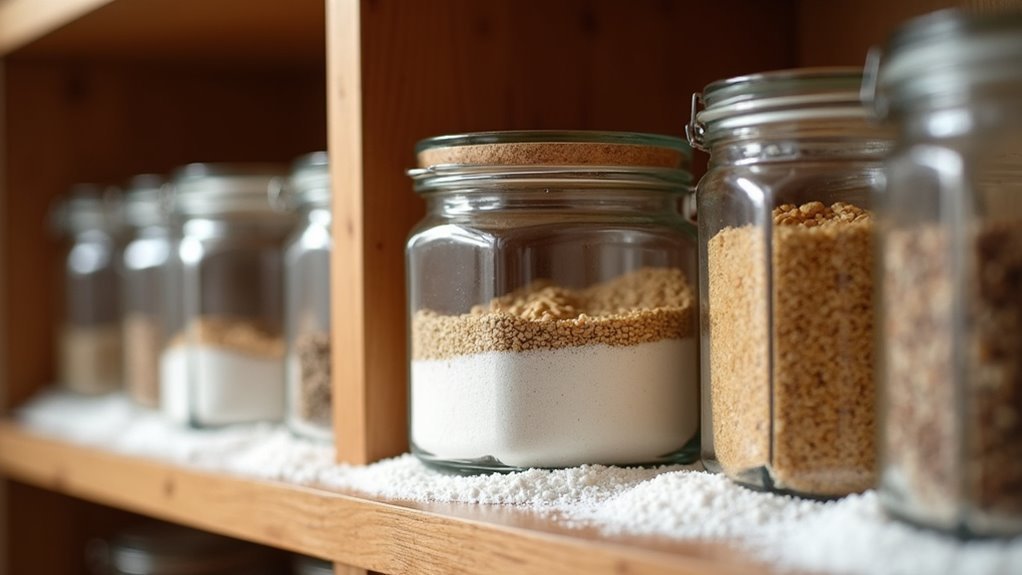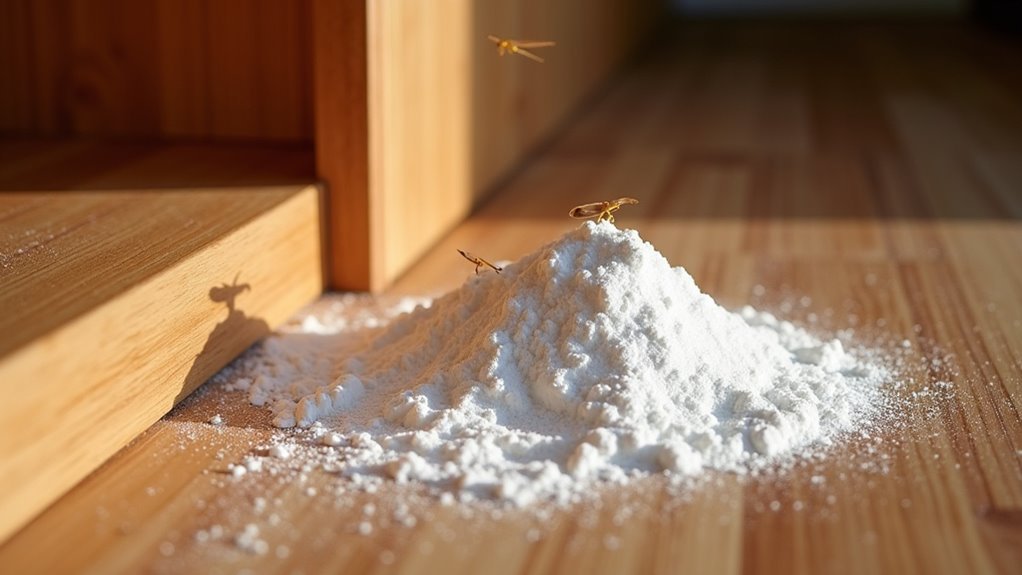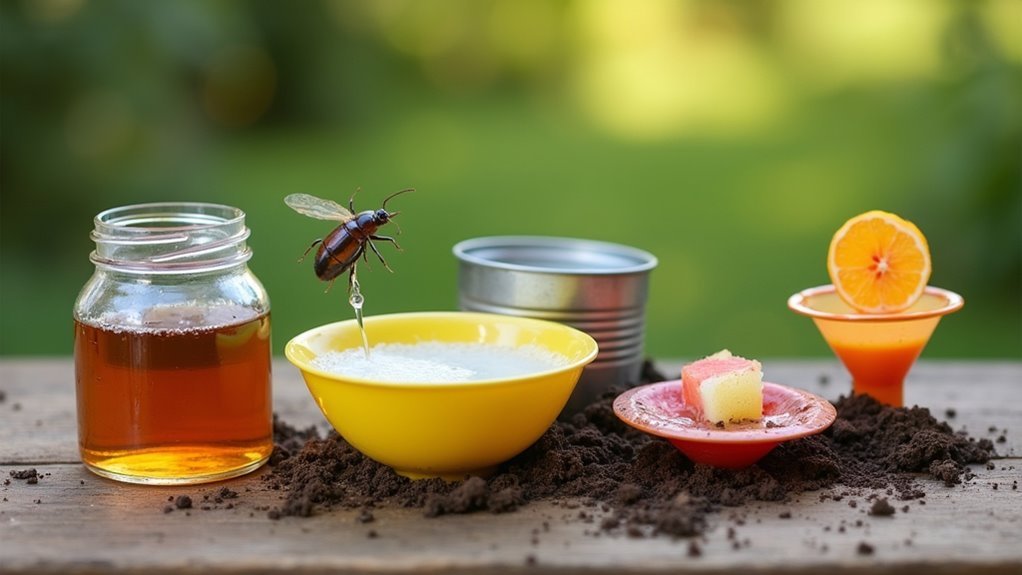You can eliminate pantry moths using several household powders that disrupt their life cycle. Sprinkle borax around cupboard perimeters and entry points as a desiccant that kills larvae. Apply diatomaceous earth in affected areas, use baking soda mixed with sugar to attract and kill moths, or spread cornstarch to disrupt larvae development. Talcum powder creates movement barriers while boric acid eradicates infestations. Combine treatments for maximum effectiveness and discover additional application techniques below.
Understanding How Borax Works Against Pantry Moths

When pantry moths invade your kitchen, borax works as a powerful desiccant that targets these pests at their most vulnerable points. This naturally occurring mineral composed of sodium, boron, and oxygen absorbs moisture from the bodies of pantry moths and their larvae upon contact. The dehydration process effectively kills them by disrupting their essential bodily functions.
You’ll find borax particularly effective against adult moths, though it also prevents larvae from maturing. When you sprinkle it in suspected areas, you’re interrupting the entire life cycle of these pests.
The powder prevents reproduction by stopping larvae from developing into breeding adults. For best results, you’ll need to combine borax treatment with thorough cleaning and proper food storage in sealed containers.
Preparing Your Pantry for Borax Treatment
Before you can effectively apply borax treatment, you’ll need to completely empty your pantry and remove every food item from the shelves. This vital preparation step allows you to properly inspect for pantry moth larvae and access all areas that require treatment.
Complete pantry evacuation is essential before borax application to ensure thorough inspection and effective treatment of all infested areas.
Follow these essential preparation steps:
- Remove all food items and inspect each one for signs of infestation.
- Perform thorough cleaning of all surfaces using hot soapy water or vinegar solution.
- Immediately dispose of any infested food by placing trash outside your home.
- Clean all cracks, corners, and crevices where moths might hide.
- Allow the pantry to dry completely before applying borax treatment.
Moisture reduces borax effectiveness, so verify all surfaces are completely dry.
Keep borax away from pets and children during application.
Creating a Borax Powder Barrier Around Food Storage Areas

You’ll need to master proper application techniques to create an effective borax powder barrier that deters pantry moths from infiltrating your food storage areas.
Strategic placement away from direct food contact guarantees safety while maximizing the powder’s desiccant properties against these persistent pests.
Understanding how long your barrier remains effective helps you maintain consistent protection through timely reapplication.
Borax Application Techniques
Creating an effective borax powder barrier requires strategic placement around your food storage areas to intercept pantry moths before they reach your provisions. This targeted approach helps eliminate a pantry moth infestation by dehydrating both adult moths and larvae on contact.
Apply borax using these essential techniques:
- Sprinkle thin lines around cupboard perimeters, focusing on entry points and cracks where moths hide.
- Target areas behind appliances and along cabinet edges to avoid food contamination in your food storage zones.
- Reapply periodically after cleaning or when you notice increased moth activity.
- Follow manufacturer’s safety instructions for proper application and handling.
- Maintain consistent coverage in treated areas to maximize effectiveness as a deterrent.
This systematic Borax application creates protective barriers that notably reduce moth populations.
Safe Barrier Placement
While proper application techniques form the foundation of borax treatment, strategic placement determines whether your barrier actually protects your food storage areas from pantry moth infiltration.
You’ll want to create continuous lines of Borax powder along pantry shelf edges, concentrating on corners where moths typically enter. Encircle food containers with thin powder rings, ensuring no gaps that allow access. Focus on high-risk zones like cracks between shelves and walls.
Safety remains paramount during placement. Keep Borax away from children’s reach by applying it behind containers or on upper shelves. Never place powder directly on food surfaces or where pets frequent.
Monitor your barrier regularly, reapplying after cleaning sessions or when you spot moth activity, maintaining consistent protection against these persistent pantry invaders.
Powder Effectiveness Duration
Most Borax powder barriers maintain their effectiveness for three to four weeks under normal pantry conditions, though several factors can extend or reduce this timeframe.
The effectiveness duration of your Borax powder treatment depends on environmental conditions and maintenance practices.
Several factors influence how long your barrier remains effective against pantry moths:
- Humidity levels – High moisture reduces powder potency and requires more frequent reapplication
- Air circulation – Drafts and ventilation can disperse the powder, shortening its lifespan
- Physical disturbance – Moving items or cleaning disrupts the barrier’s integrity
- Temperature fluctuations – Extreme heat or cold affects the powder’s pest-repelling properties
- Initial application thickness – Thicker layers generally last longer than thin applications
You’ll need to reapply regularly for continued protection.
Applying Borax in Cracks and Crevices Where Moths Hide

You’ll need to pinpoint where pantry moths actually hide before applying borax effectively in your kitchen.
Focus on inspecting cracks around cabinets, gaps behind appliances, and crevices near food storage areas where these pests typically congregate.
Once you’ve identified these hiding spots, you can safely apply borax using targeted methods that won’t contaminate your food preparation areas.
Identifying Hidden Moth Areas
Since pantry moths excel at finding obscure hiding spots throughout your kitchen, you’ll need to target areas beyond the obvious pantry shelves to achieve complete elimination.
These persistent pests infiltrate spaces where crumbs accumulate and create ideal breeding conditions away from your stored foods.
Focus your inspection on these critical areas:
- Behind refrigerators, stoves, and other large appliances where debris collects
- Along baseboards and floor corners where food particles settle
- Inside cabinet hinges and door frames with tight cracks and crevices
- Under sink areas and around plumbing fixtures
- Behind small appliances like toasters and coffee makers
Regular monitoring of these hidden zones helps you identify moth activity before infestations spread.
Combine thorough inspections with pantry moth traps to detect early warning signs and target problematic areas effectively.
Safe Borax Application Methods
Once you’ve pinpointed these hidden moth hideouts, borax provides an effective treatment method for eliminating pests in hard-to-reach spaces.
Sprinkle a thin layer along shelf edges, behind appliances, and in cupboard corners after thoroughly cleaning away food particles. This desiccant dehydrates and kills moths and larvae upon contact, making it highly effective against moth infestations.
You’ll need to keep borax strictly away from food items and surfaces that contact food directly. Apply it only in non-food areas for safety.
Reapply every few weeks, especially after cleaning, to maintain effectiveness against new moths entering your pantry. Vacuum excess borax after several days to prevent accumulation while monitoring for continued activity.
Using Borax Mixed With Diatomaceous Earth for Enhanced Control
When pantry moths prove particularly stubborn, combining borax with diatomaceous earth creates a dual-action treatment that attacks these pests from multiple angles.
This powerful mixture targets both larvae and adult pantry moths through different mechanisms, greatly increasing your chances of complete elimination.
Here’s how to maximize this combination’s effectiveness:
- Mix equal parts borax and diatomaceous earth in a shaker container
- Sprinkle the mixture in pantry corners, shelf edges, and cracks where moths hide
- Keep the treatment dry to maintain its pest-killing properties
- Reapply weekly until you see no more moth activity
- Combine with thorough cleaning and proper food storage practices
The borax disrupts larvae digestive systems while diatomaceous earth dehydrates adults by damaging their exoskeletons, creating extensive coverage against infestations.
Treating Pantry Shelves and Cupboard Corners With Borax
When you’re treating pantry shelves and cupboard corners with borax, you’ll need to take proper safety precautions to protect children and pets from accidental ingestion.
Focus your application on hidden areas where moth larvae typically congregate, such as cracks, crevices, and corners where they’re less likely to be disturbed.
Use effective powder distribution methods that create a thin, even layer to maximize contact with moths while making cleanup manageable.
Borax Application Safety Precautions
Before you begin treating your pantry shelves and cupboard corners with borax, you’ll need to take several critical safety precautions to protect yourself and your family.
Proper borax application requires careful preparation to effectively eliminate pantry pests while maintaining household safety:
- Remove and securely store all food items from treated areas to prevent contamination.
- Wear protective gloves and a mask during application to avoid skin contact and inhalation.
- Keep children and pets away from treated areas until borax is completely cleaned up.
- Allow borax to sit for several hours or overnight before vacuuming for maximum effectiveness.
- Inspect and reapply regularly in moth-prone areas as part of ongoing pest control.
Following these precautions guarantees you’ll safely eliminate pantry moths while protecting your family from potential exposure.
Targeting Hidden Moth Larvae
After you’ve prepared your pantry safely, focus your borax application on the hidden spaces where moth larvae thrive undetected.
Create a thin layer of Borax in pantry corners, shelf cracks, and crevices where pantry moths typically lay eggs. These dehydrating properties disrupt the larvae’s ability to survive and develop into adult moths.
Apply the powder strategically behind containers, along shelf edges, and in tight spaces that regular cleaning often misses. The more surface area you cover in these hiding spots, the higher your chances of eliminating existing larvae populations.
Reapply Borax regularly, especially after deep cleaning sessions, to maintain an effective barrier.
This consistent approach prevents future infestations while targeting any remaining larvae that might’ve survived initial treatment efforts.
Effective Powder Distribution Methods
Since proper distribution determines your treatment’s success, you’ll need specific techniques to guarantee extensive borax coverage across all pantry surfaces.
Apply this effective powder strategically to maximize its impact against pantry moths:
- Target dark corners and crevices where moths typically hide and lay eggs
- Create thin, even layers on shelf surfaces without overwhelming the area
- Focus on undisturbed spaces behind containers and along back walls
- Avoid direct contact with food preparation areas to prevent contamination
- Reapply regularly after cleaning sessions to maintain consistent protection
Remember that borax works by disrupting moths’ digestive systems and dehydrating them upon contact.
Your distribution method directly affects how quickly you’ll eliminate the infestation.
Combine this powder treatment with traps and thorough cleaning for extensive pest control results.
Borax Application Behind Appliances and Hard-to-Reach Areas
While pantry moths typically congregate in visible food storage areas, their eggs and larvae often hide in the dark recesses behind appliances where traditional cleaning methods can’t reach.
Borax becomes particularly valuable when targeting these hard-to-reach areas where pantry moths prefer to feed and reproduce undisturbed.
Before applying Borax, you’ll need to thoroughly clean these spaces, removing all food particles and visible larvae.
Apply the powder in thin, even layers directly onto surfaces where moths are likely to hide. Focus on gaps behind refrigerators, stoves, and cabinets where darkness provides ideal breeding conditions.
Since Borax acts as a desiccant, it’ll dehydrate insects upon contact.
Regularly check these hidden areas and reapply the treatment when moth activity reappears to maintain long-term effectiveness.
Combining Borax With Essential Oils for Natural Moth Deterrence
Although Borax proves effective on its own, combining it with essential oils creates a powerful dual-action treatment that both eliminates existing moths and prevents new infestations.
Borax paired with essential oils delivers a one-two punch against moths, tackling current problems while blocking future invasions.
This natural moth deterrent combines borax’s dehydrating properties with essential oils’ repelling scents.
To create your borax and essential oil mixture:
- Mix 2 tablespoons borax with 5-10 drops of peppermint or lavender essential oils
- Sprinkle the mixture in pantry corners, along shelves, and near entry points
- Focus on cracks, crevices, and areas where you’ve spotted moth activity
- Reapply every 2-3 weeks to maintain effectiveness
- Store unused mixture in a sealed container away from children and pets
You’ll target both adult moths and larvae while creating an environment that discourages future infestations.
Keep this treatment away from food items and preparation surfaces.
Safety Precautions When Using Borax Around Food Areas
Even though borax offers an effective natural solution for pantry moth control, you must take proper safety measures when applying it near your food storage areas. Following essential safety precautions protects your family and pets from potential health risks while maintaining effective pest control.
| Safety Step | Action Required |
|---|---|
| Food Protection | Remove or cover all food items and utensils |
| Label Compliance | Follow packaging instructions for safe dosage |
| Child/Pet Safety | Store borax in inaccessible locations |
| Post-Application | Clean areas thoroughly with soap and water |
| Strategic Placement | Apply in cracks and crevices, not open surfaces |
Always prioritize targeted application in hidden areas rather than exposed surfaces. This approach effectively eliminates pantry moths while minimizing accidental exposure risks in food areas where borax treatments are applied.
Maintaining Long-Term Pantry Protection With Regular Borax Applications
Three key principles form the foundation of successful long-term pantry moth prevention using borax: consistent application timing, strategic placement, and integrated pest management.
You’ll achieve lasting pantry moths protection by establishing a routine maintenance schedule. Borax works by dehydrating moths and larvae upon contact, making regular applications essential for continuous effectiveness.
- Sprinkle thin borax layers in pantry corners and crevices where moths typically hide
- Reapply every few months or after cleaning your pantry thoroughly
- Combine borax with diatomaceous earth for enhanced pest control results
- Monitor for renewed moth activity and treat immediately when detected
- Focus on creating an inhospitable environment that prevents new infestations
Your long-term protection strategy should treat existing problems while preventing future moth populations from establishing themselves in your food storage areas.
Frequently Asked Questions
How Do You Make Homemade Pantry Moth Killer?
Mix equal parts food-grade diatomaceous earth and baking soda to create a homemade pantry moth killer. Sprinkle this powder mixture in areas where moths hide to dehydrate and eliminate both adult moths and their larvae effectively.
What Is the Fastest Way to Get Rid of Pantry Moths?
You’ll eliminate pantry moths fastest by completely emptying your pantry, vacuuming all shelves thoroughly, and discarding infested food. Then wipe surfaces with vinegar solution and set up pheromone traps immediately.
Do Pantry Moths Like Baking Powder?
Pantry moths aren’t attracted to baking powder since they prefer grains and flours. You can actually use baking powder for cleaning pantry surfaces, and its moisture-absorbing properties help deter moths.
What Is the Best Chemical for Pantry Moths?
You’ll find boric acid works best for pantry moths since it’s toxic when ingested and kills both larvae and adults effectively. Apply it carefully in pantry corners away from direct food contact.
In Summary
You’ve now got a complete arsenal of borax-based treatments to eliminate pantry moths from your home. Remember, consistency’s key—you’ll need to reapply treatments regularly and maintain clean storage practices. Don’t forget those safety precautions, especially around food areas. With these ten methods in your toolkit, you’re well-equipped to keep your pantry moth-free year-round. Stay vigilant, rotate your treatments, and you’ll enjoy a pest-free kitchen.





Leave a Reply